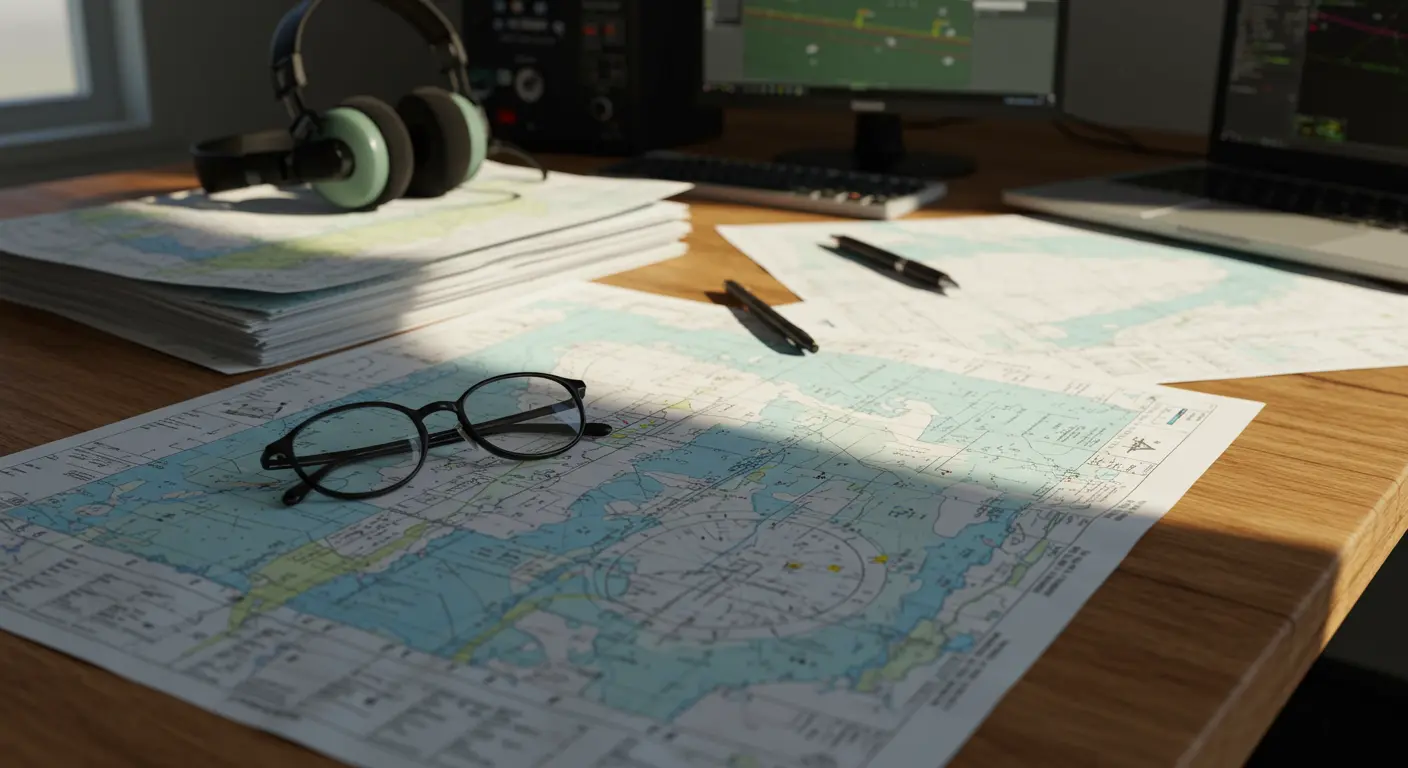What Is an Approach Chart?
An approach chart—also known as an approach plate—acts as a pilot’s essential guide during instrument approaches, containing all the essential information needed to navigate safely from cruise flight to touchdown when visibility is compromised.
These comprehensive documents map out approach routes, descent profiles, and missed approach procedures. They also specify communication frequencies, landing minimums, potential hazards, and essential airport data.
These charts excel at their ability to translate complex three-dimensional flight procedures into a standardized, two-dimensional format that pilots can interpret quickly—even under pressure.
Key Sections of Approach Charts
Approach charts are organized into four distinct sections, each tailored to a specific phase of the approach procedure—understanding their interpretation is essential to safe instrument flying.
The four primary sections of an approach chart are:
-
Approach Briefing Strip
-
Plan View
-
Profile View
-
Landing Minimums
FAA charts also include an airport diagram section for ground reference after landing.
Understanding the Briefing Strip
Positioned at the chart’s top, the briefing strip acts as your quick-reference hub. It displays the procedure name (such as “ILS RWY 27”), immediately identifying both the approach type and target runway.
Essential communication and navigation frequencies are prominently listed here, alongside the chart’s effective date—your guarantee of currency.
Special symbols serve as warnings, highlighting non-standard requirements like mandatory equipment or operational restrictions. Additional data encompasses the airport identifier and field elevation.
Experienced pilots review this section first. Why? It allows them to configure equipment properly and construct a mental framework of the entire procedure—significantly improving situational awareness while minimizing cockpit workload.
Decoding the Plan View
Think of the plan view as your bird’s-eye roadmap. It charts the aircraft’s horizontal journey from the Initial Approach Fix (IAF) all the way to the runway threshold.
The approach path unfolds with precise course headings, distances, and altitude or airspeed constraints. Segments are clearly delineated using fixes, intersections, and navigational aids (Avoids).
The Minimum Safe Altitude (MSA) circle provides an important safety reference—it defines the lowest altitude that ensures obstacle clearance within a specified radius. This becomes your emergency altitude reference.
Beyond the primary approach path, this view reveals terrain features, obstacles, and restricted airspace. Many charts include a helpful inset detailing the missed approach’s horizontal track.
Breaking Down the Profile View
The profile view shifts perspective to a side-on cross-section, revealing the approach’s vertical dimension—your descent path and altitude transitions.
Two critical waypoints appear in this view: the Final Approach Fix (FAF), where your final descent to landing commences, and the Missed Approach Point (MAP)—your decision point for executing a missed approach if visual references aren’t established.
The descent profile line becomes your visual guide for planning power settings and aircraft configuration. Step-down fixes appear with their corresponding minimum altitudes, ensuring you maintain obstacle clearance throughout the procedure.
Terrain features that could impact your approach path are clearly depicted, providing essential obstacle awareness. Precision approaches like ILS show the glide slope angle and decision height, while non-precision approaches highlight minimum descent altitudes and visual descent points.
Understanding the Minimums Section
Anchoring the chart’s bottom, the minimums section provides the critical data for approach completion—organized by aircraft approach category and equipment capabilities.
Two fundamental values define your limits: Decision Altitude/Height (DA/DH) for precision approaches or Minimum Descent Altitude (MDA) for non-precision procedures, paired with required flight visibility.
The rule is absolute: reach minimum altitude without acquiring the required runway visual references, and you must immediately execute the missed approach procedure. No exceptions.
This section also specifies equipment requirements or pilot qualifications, and may present varying minimums based on available approach lighting systems.
Common Symbols and Their Meanings
Approach charts employ a standardized symbol language to communicate complex information very efficiently. Procedure tracks—solid lines for primary approach paths, dashed lines for missed approach routes—guide your navigation with accompanying bearing information showing both magnetic and true courses.
Radio navigation aids (Avoids) are shown with distinctive symbols, each including an identifier and frequency:
-
VOR (VHF Omnidirectional Range): Typically shown as a compass rose.
-
NDB (Non-Directional Beacon): Depicted as a small square or triangle.
-
ILS (Instrument Landing System): Indicated with specialized symbols for the localizer and glideslope components.
Waypoints and fixes carry distinct symbols based on their function. Compulsory reporting points, where air traffic control contact is mandatory, stand apart from standard fixes. Altitude restrictions appear as numbers within specific notations—clearly indicating minimum, maximum, or mandatory crossing altitudes.
Missed approach symbols require careful attention. They show clear guidance for pilots facing unsuccessful approaches—detailing the path, altitudes, and procedures for transitioning safely to a holding pattern or alternate procedure.
Obstacle symbols mark potential hazards with elevations prominently displayed. Special use airspace, including restricted areas, appears with distinctive boundary markings that require attention.
Keeping Your Approach Charts Current
Chart currency isn’t just good practice—it’s a critical safety imperative. Aeronautical data changes regularly, and flying with outdated charts creates both safety hazards and regulatory violations.
Every flight demands current charts. Pilots must verify that updates from aviation authorities (typically issued on 28- or 56-day cycles) are properly installed, particularly on Electronic Flight Bags (FBS).
Chart format consistency matters too. Sticking with a single publisher—whether Jespersen or FAA—builds familiarity that leads to better efficiency and reduced cockpit workload.
Pre-flight NOTAM (Notices to Airmen) review is essential. These notices reveal temporary changes that current charts might not yet reflect—closed runways, inoperative navigation aids, or modified procedures that could significantly affect your approach planning.
Professional and general aviation pilots increasingly rely on subscription services to maintain currency automatically, ensuring access to the latest navigational information without the administrative burden.
Conclusion
Approach chart mastery is a fundamental skill for instrument pilots. These sophisticated documents transform complex procedures into standardized, interpretable guidance—enabling safe landings when visibility disappears.

